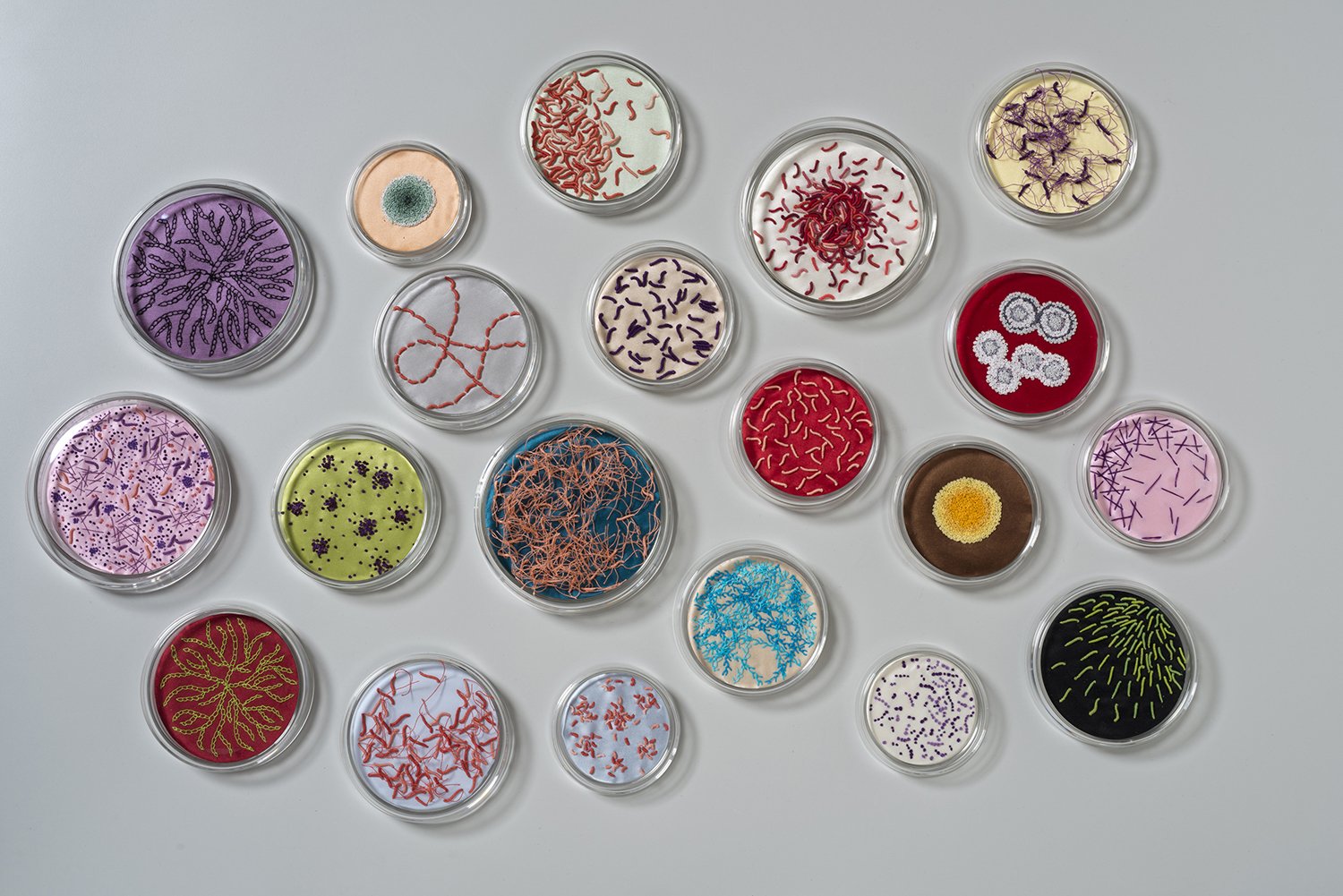Embroidery
Adapting to New Substrates is my fantasy that microorganisms and larvae will evolve to live on and digest various plastics –plastic bags, Styrofoam, bubble wrap, face masks, and plastic cups–that clog our environment. Certain embroidery stitches startlingly resemble bacteria, fungus colonies, fungal structures like mycelia and branching septate hyphae, and moth larvae, as seen through a microscope and in actual size. Researchers worldwide are working to cultivate bacteria whose enzymes break down plastic. Wax moth larvae have been found that eat plastic. Beetle larvae, known as superworms, have been shown to digest Styrofoam. However, these solutions will have to be practical on the global scale to manage the increasing amounts of plastic accumulating on the planet.
Adapting to New Substrates 4.0, 2023. Hand embroidery on various plastics. 50” x 56” x 6”
Adapting to New Substrates 4.0, detail
Devour III, 2017. Hand embroidery. Foam meat tray, embroidery floss. 5 3/4” x 8 1/4” x 1”
Devour III, detail
Thank You, 2017. Hand embroidery. Plastic bag, embroidery floss. 10” x 8” x 1”
Thank You, detail
Adapting to New Substrates 4.0, detail
Devour II, 2017. Hand embroidery. Foam meat tray, embroidery floss. 5 3/4” x 8 1/4” x 1”
Thank You II, 2017. Hand embroidery. Plastic bag, embroidery floss. 10” x 8” x 1”
Devour II, detail
Thank You II, detail
I've been fascinated with shapes of bacteria since I majored in bacteriology in college. Recently, while taking an embroidery class, I was startled to find that particular stitches resembled bacterial rods and cocci, and fungal structures like mycelia and hyphae. Using the colors of stains, agar media, and light microscope fields in the laboratory, I embroidered specific bacteria referring to their actual stained colors (purple for Gram positive and orange/pink for Gram negative stain) and characteristics such as relative size, flagella, endospores, arrangement pattern, immunofluorescence, and others. Setting them into Petri dishes places them in a laboratory context.
What’s In You and On You 4.0, 2022. Hand embroidery. Fabric, embroidery floss, glass Petri dishes. Dimensions variable. 21 from a set of 48.
What’s In You and On You 4.0, 2022. Hand embroidery. Fabric, embroidery floss, glass Petri dishes. Dimensions variable. 20 from a set of 48.
What’s In You and On You: Normal Flora and Pathogens 1.2, 2019. Hand embroidery. Fabric, embroidery floss, glass Petri dishes. 1” x 28” x 20”
Normal Flora Colon, 1” x 5” x 5”
Normal Flora Vagina, 1” x 5” x 5”
Escherichia coli, 7/8” x 4 1/4” x 4 1/4”
Normal Flora Skin, 1” x 5” x 5”
Salmonella species, 7/8” x 4 1/4” x 4 1/4”
Clostridium tetani, 3/4” x 3 3/4” x 3 3/4”
Normal Flora Mouth, 1” x 5” x 5”
Staphylococcus aureus, 7/8” x 4 1/4” x 4 1/4”
Serratia marcescens, 7/8” x 4 1/4” x 4 1/4”
Mycobacteria tuberculosis, 3/4” x 3 3/4” x 3 3/4”
Pseudomonas aeroginosa, 3/4” x 3 3/4” x 3 3/4”
Neisseria gonorrhoeae, 3/4” x 3 3/4” x 3 3/4”
Branching septate hyphae, 3/4” x 3 3/4” x 3 3/4”
Clostridium botulinum, 7/8” x 4 1/"4” x 4 1/4”
Aspergillus fumigata, 3/4” x 3 3/4” x 3 3/4”
Microbiology Lab Series 30, 2016. Hand embroidery. Fabric, embroidery floss, glass Petri dishes
Microbiology Lab Series 50, 2017. 1” x 30” x 40”
Installation view, Sanchez Art Center, Pacifica, CA. 50|50 Show, 2017. Hand embroidery. Fabric, embroidery floss, glass Petri dishes.
“I don’t like the way I look in pictures. A low resolution image obscures details. I can live with that.”
8-bit Ruth, 2019. Hand embroidery. Embroidery floss. 12” x 12” x 1.5”
8-bit Ruth, detail
For the What Linens Know series, I've embroidered pictures of food like bread crumbs, gravy, chicken bones; glass rings from wine, water, coffee; and blood from a bloody nose to leave a history of how the vintage linen was used.
What Linens Know, 2012. Hand embroidery. Vintage linens, embroidery floss. 37” x 53” installed.
Bloody nose
Rust
Gravy
Dried Petals and Pollen
Red wine
Chicken bones

